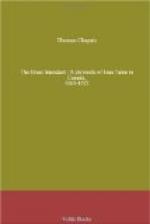The victory was now complete, and the army could go to rest after nearly twenty-four hours of continuous exertion. Next morning the French were astonished at the sight of Andaraque in the light of the rising sun. instead of a collection of miserable wigwams, they saw a fine Indian town, with wooden houses, some of them a hundred and twenty feet long and with lodging for eight or nine families. These houses were well supplied with provisions, tools, and utensils. An immense quantity of Indian corn and other necessaries was stored in Andaraque-’food enough to feed Canada for ten years’—and in the surrounding fields a plentiful crop was ready for harvest. All this was to be destroyed; but first an impressive ceremony had to be performed. The army was drawn up in battle array. A French officer, Jean-Baptiste Dubois, commander of the artillery, advanced, sword in hand, to the front, and in the presence of Tracy and Courcelle, declared that he was directed by M. Jean Talon, king’s counsellor and intendant of justice, police, and finance for New France, to take possession of Andaraque, and of all the country of the Mohawks, in the name of the king. A cross was solemnly planted alongside a post bearing the king’s coat of arms. Mass was celebrated and the Te Deum sung. Then the work of destruction began. The palisades, the dwellings, the bastions, the stores of grain and provisions, except what was needed by the invaders, the standing crops-all were set on fire; and when night fell the glaring illumination of that tremendous blaze told the savages that at last New France had asserted her power, and that the soldiers of the great king had come far enough through forest and over mountain and stream to chastise in their own country the bloodthirsty tribes who for a quarter of a century had been the terror of the growing settlements on the St Lawrence.




